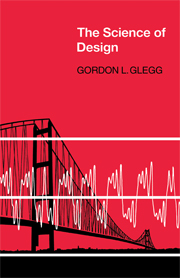Book contents
- Frontmatter
- Contents
- Preface
- 1 The Overall Picture — Plan View
- 2 The Overall Picture — Elevation
- 3 Special Cases
- 4 A Rogue of Variables
- 5 Journeys into Lilliput
- 6 Transformations and Translations
- 7 The Dictatorship of Time
- 8 Looking, Seeing and Believing
- 9 The Consortium
- 10 The Art of Conversation
- 11 Conclusions and Recommendations
- References and Notes
- Index
11 - Conclusions and Recommendations
Published online by Cambridge University Press: 04 August 2010
- Frontmatter
- Contents
- Preface
- 1 The Overall Picture — Plan View
- 2 The Overall Picture — Elevation
- 3 Special Cases
- 4 A Rogue of Variables
- 5 Journeys into Lilliput
- 6 Transformations and Translations
- 7 The Dictatorship of Time
- 8 Looking, Seeing and Believing
- 9 The Consortium
- 10 The Art of Conversation
- 11 Conclusions and Recommendations
- References and Notes
- Index
Summary
For reasons that I have outlined in another book, I always advise designers to state their facts and ideas in drawings and diagrams if they can, for words and figures often involve another abstract step. Possibly I may be wise to accept my own advice and so I have prepared a single diagram (Fig. 12) incorporating my conclusions, and my recommendation is that you should have a good look at it.
‘It looks to me like a map of the London Underground gone mad.’
Well, in a sense, it is a map, for it outlines the basic mental and research routes that a designer can follow when searching for data. In a sense it is an index too, for the numbers in circles are those of the chapter in the book dealing with that particular part of the map.
‘What use do you think all that will be?’
I suggest that the first thing you do, when given the responsibility of finding out by research some missing facts that you need for designing, is to take a long hard look at this diagram. It contains, in principle, all the options open to you.
‘What can I do if I don't know enough about a problem to decide in advance where to put it on the map?’
You must do some preliminary research into what is going on. It is surprising how, sometimes at least, you can play about with bits and pieces of things and so quite quickly get the general feel of what it is all about.
- Type
- Chapter
- Information
- The Science of Design , pp. 88 - 90Publisher: Cambridge University PressPrint publication year: 1973



